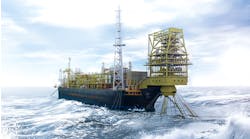Alfa Laval has introduced PureBallast, a chemical-free process designed to prevent involuntary transportation of invasive species in ballast water. The technique also complies with new IMO regulations due to take effect in 2009 to tackle this problem.
PureBallast incorporates advanced oxidation technology (AOT), which eliminates the need for carrying or handling chemicals onboard the vessel. Depending on the vessel’s ballast water volume, one or more AOT units can be installed to treat the water during ballasting and de-ballasting operations.
These units contain titanium dioxide catalysts that generate radicals when struck by light. The radicals, which have a life-span of only a few milliseconds, break down the cell membrane of microorganisms without the use of chemicals or the creation of harmful residuals.
The compact system is modular, allowing it to fit easily into engine rooms, thanks to a block-component structure that allows it to be installed between normal ballast water system components. There are no moving parts and few consumables, so the system can be maintained with minimum effort.
Treatment of water with PureBallast occurs in two stages - pre-treatment and end-treatment. During ballasting, water passes through a pre-filter to remove any larger particles and organisms. The water then continues to the AOT unit, which generates the radicals that effectively break down smaller organisms that have passed the filter. Thanks to the pre-filter stage, sediment buildup in the ballasting tanks is avoided, and any backflushing water is returned to the sea directly at the ballasting location.
During de-ballasting, water again passes through the AOT unit to ensure that any organisms that might have re-grown in the tanks while the vessel is in transit are destroyed. The filter, however, is bypassed, thereby preventing filter backflushing. This eliminates the risk of contamination via the filter at the de-ballasting site.
The whole process is fully automated, with monitoring of alarms, and both local and remote operations are possible. To ensure the AOT unit performance is not affected by scaling from seawater contaminants, an automatic cleaning system has been integrated into the unit.
According to Alfa Laval, pilot tests of PureBallast, conducted last year by the Norwegian Institute for Water Research and supervised by DNV, revealed that the process conformed with IMO standards for ballast water treatment. These tests also showed that PureBallast leaves no residual compounds or toxicity following ballast water treatment.
Since 2003, a full-scale prototype PureBallast also has been operating onboard an ocean-going vessel, the Walenius-owned vehicle carrierM/V Don Quijote. Following favorable feedback, another system was installed last year on the newbuild Aida.
Alfa Laval aims to have the first fully approved ballast water treatment system, with certification, completed by mid-2007. But based on the test results and trials to date, the product is available for commercial use already.
For more information, contact Andre Szczerba, Alfa Laval Tumba. Tel: +46 8 530 65000, fax: +46 8 530 34555,[email protected], www.alfalaval.com


